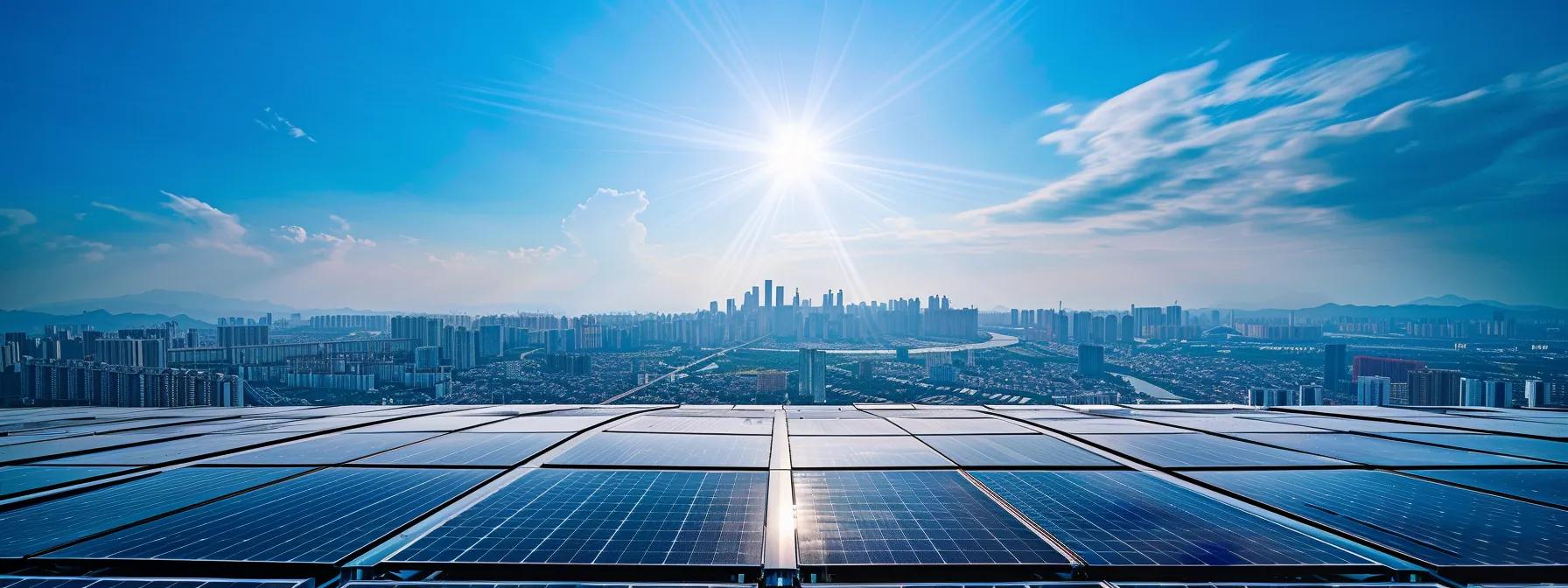
Solar panels convert sunlight into usable electricity for homes and businesses through a process known as the photovoltaic effect. This article explains how solar panels work by exploring the science behind the effect, the key components that make up a solar panel, and the different available technologies. You will also learn about factors influencing solar panel efficiency, how the generated electricity is integrated into electrical systems, and the installation and maintenance processes. Whether you are considering switching to renewable energy for cost savings, environmental benefits, or energy independence, this guide provides the practical insights needed for making an informed decision.
Transitioning into the main content, each section addresses common questions on solar panels and their operation, highlighting both the underlying science and real-world applications.
What Is the Photovoltaic Effect and How Does It Convert Sunlight Into Electricity?
The photovoltaic effect is the core process by which solar panels convert sunlight into electricity. When photons strike a semiconductor—usually silicon—in a solar cell, they transfer energy to electrons, freeing them from atomic bonds. This process converts light energy directly into electric current without moving parts or emissions, making it a key mechanism in renewable energy systems.
What Happens When Photons From Sunlight Hit Silicon in Solar Cells?
When photons hit silicon, they dislodge electrons and create electron-hole pairs. The silicon is doped to form a p-n junction, which establishes an electric field. This field forces the free electrons toward a metal contact where they accumulate and flow through an external circuit, generating direct current (DC) electricity.
How Do Excited Electrons Create an Electric Current in Solar Panels?
Once electrons are freed, the electric field in the p-n junction drives them toward metal contacts. Their flow through an external circuit produces electrical current proportional to the number of dislodged electrons. Optimizing cell architecture and silicon purity improves this conversion efficiency, resulting in a higher electrical output for powering devices or charging batteries.
Why Is the Photovoltaic Effect Essential for Solar Energy Production?
This effect is essential because it converts sunlight into electricity in a clean, efficient, and reliable manner. It forms the foundation of renewable energy systems—from home installations that lower bills to large-scale solar farms that reduce fossil fuel dependence and lower greenhouse gas emissions. Ongoing improvements in photovoltaic technology drive further cost-effectiveness and efficiency for sustainable energy.
What Are the Main Components of a Solar Panel and Their Roles?

Solar panels are composed of several essential components that work together to convert sunlight into electricity and protect the system from environmental damage.
What Are Photovoltaic Cells and How Do They Work?
Photovoltaic cells are the active elements in a solar panel. Typically made from silicon, these cells convert sunlight into electricity by using the photovoltaic effect. They are arranged in series or parallel to boost voltage and current output. Advances in cell design have increased conversion efficiencies, making them vital for effective solar energy production.
How Does Silicon Function as the Semiconductor Material in Solar Panels?
Silicon is favored for its abundance and stable performance. It is processed into monocrystalline or polycrystalline forms, each offering different efficiency and cost characteristics. Doping silicon creates the necessary electric fields for the photovoltaic effect, while its crystalline structure ensures that released electrons follow a clear path, contributing to the panel’s longevity and effectiveness over decades.
What Other Materials and Structures Make Up a Solar Panel?
Beyond the photovoltaic cells, solar panels include: – Tempered Glass: Protects the cells while maximizing light transmission. – Encapsulant: Insulates and protects cells from moisture. – Backsheet: Shields the internal components from environmental damage. – Metal Frames and Junction Boxes: Provide structural support and manage electrical connections. Together, these elements form a robust assembly that endures harsh weather and maintains optimal performance.
What Are the Different Types of Solar Panels and How Do They Compare?
Solar panels are available in several types, each suited to different needs and budgets. The three main types are monocrystalline, polycrystalline, and thin-film panels, each with unique advantages.
What Are Monocrystalline Solar Panels and Their Advantages?
Monocrystalline panels are made from single-crystal silicon, offering high efficiency (often above 20%) and a uniform dark appearance. They perform well in low-light conditions and are ideal for installations with limited space. Although they are more expensive, their high power output per unit area often justifies the cost for residential and commercial applications.
How Do Polycrystalline Solar Panels Differ From Monocrystalline?
Polycrystalline panels are created by melting multiple silicon crystals, resulting in a bluish, less uniform appearance. They generally offer efficiencies around 15-18%, are more cost-effective, and produce less environmental impact during manufacturing. They are well suited for larger installations where space constraints are less critical.
What Are Thin-Film Solar Panels and When Are They Used?
Thin-film panels use layers of semiconductor materials deposited on substrates like glass or metal. They are lightweight, flexible, and perform relatively well in high temperatures, though their efficiency is lower (around 10-12%). These panels are ideal for unconventional surfaces or applications requiring lightweight or aesthetically integrated solutions.
How Efficient Are Solar Panels and What Factors Affect Their Performance?

Solar panel efficiency measures the ratio of sunlight converted into usable electricity. Several key factors influence this efficiency:
What Factors Influence Solar Panel Efficiency?
Efficiency is affected by: – Material Quality: Purity of silicon and quality of cell construction. – Cell Design: Precision in the p-n junction, anti-reflective coatings, and wiring. – Environmental Conditions: Temperature, shading, dust, and the panel’s tilt and orientation. Even small improvements in material or design can lead to significant increases in total energy production over a panel’s lifetime.
How Is Solar Panel Output Measured and Rated?
Output is measured in watts (W) under standard test conditions (STC), which provide consistent benchmarks like light intensity and temperature. Metrics such as performance ratio and capacity factor further help gauge real-world performance, ensuring systems meet design and energy production goals.
What Are the Best Practices to Maximize Solar Panel Performance?
Maximizing performance involves: – Optimal Tilt and Orientation: Ensuring maximum sun exposure. – Quality Mounting Systems: Reducing shading and tracking issues. – Regular Cleaning and Maintenance: Preventing dust and debris buildup. – Robust Electrical Connections: Minimizing losses in wiring and inverter systems. Using advanced monitoring can also detect deviations early, preserving long-term efficiency.
How Is Solar Panel Electricity Converted and Used in Homes and Businesses?
Solar panels generate DC electricity, which is converted to AC electricity to power most homes and businesses.
What Is Direct Current (DC) and How Do Solar Panels Produce It?
DC is produced when sunlight triggers the photovoltaic effect in the solar cells. The free electrons flow steadily through wiring connections, and the configuration of these cells determines the overall voltage and current output available from the panels.
How Does an Inverter Convert DC to Alternating Current (AC)?
An inverter converts DC to AC using semiconductor switches that alternate the input polarity at high speeds, effectively mimicking an AC signal. Filtering and voltage stabilization ensure the AC output meets grid standards. Reliable inverters also incorporate monitoring features to handle power fluctuations effectively.
How Is Solar Energy Integrated Into Home and Commercial Electrical Systems?
After AC conversion, solar energy is fed into a building’s electrical system via circuit breakers and metering devices. In grid-tied systems, surplus electricity returns to the grid through net metering, which credits the energy bill. In off-grid systems, batteries store excess energy for later use. Proper integration ensures safety and enhances energy independence.
What Is the Process for Installing and Maintaining Solar Panels?

Effective installation and regular maintenance are essential for long-term solar panel performance and safety.
What Are the Key Steps in Solar Panel Installation?
Installation begins with a site assessment to determine roof condition, sun exposure, and available space. A customized layout is designed and permits are obtained before panels are securely mounted at an optimal angle. Electrical wiring connects the panels to an inverter and the home’s grid. A final inspection ensures compliance with safety standards, and advanced tools or AI can help streamline this process.
How Should Solar Panels Be Maintained for Optimal Efficiency?
Regular maintenance includes cleaning the panels to remove dust and debris, inspecting for physical damage or wiring issues, and conducting periodic performance tests. Professional inspections ensure that systems operate within expected output ranges, protecting the investment and prolonging system life.
How Can Common Solar Panel Issues Be Troubleshot?
Common issues include shading effects, soiling, and inverter malfunctions. Using monitoring software can help detect drops in performance early. Professional inspections may reveal minor defects such as micro-cracks or loose wiring that can be addressed before causing significant energy losses.
What Are the Environmental and Economic Benefits of Using Solar Panels?
Solar panels provide important environmental and economic advantages beyond energy production.
How Do Solar Panels Reduce Environmental Impact?
By reducing dependence on fossil fuels, solar panels lower greenhouse gas emissions and air pollution. A typical residential system can offset significant amounts of carbon dioxide. As a renewable source, they conserve natural resources while helping to combat climate change.
What Cost Savings Can Solar Panels Provide Over Time?
Solar installations lead to lower electricity bills, protection against rising energy costs, and improved returns on investment. Tax credits, rebates, and other incentives further reduce upfront costs and accelerate savings over the system’s lifespan.
What Government Incentives Support Solar Panel Adoption?
Incentives such as federal and state tax credits, rebates, and net metering programs help lower the initial installation costs. These programs make solar energy more accessible and economically attractive, contributing to a broader shift toward sustainable energy practices.
How Is Solar Panel Electricity Converted and Used in Homes and Businesses? (Additional Insights)
After conversion from DC to AC via an inverter, solar-generated electricity is distributed through a building’s wiring system. Excess energy can be managed through net metering or stored in batteries. Advanced systems use smart inverters that communicate with grid operators to optimize electricity flow, manage peak loads, and provide backup power during outages, enhancing both energy independence and system stability.
What Is the Process for Installing and Maintaining Solar Panels? (Additional Insights)

Successful installation requires detailed planning, including roof integrity checks, shading analysis, and custom design to maximize sunlight exposure. Post-installation, regular inspections and cleaning ensure that all components—from mounting hardware to electrical wiring—function correctly. Proactive maintenance, aided by real-time monitoring, helps detect and address issues early, ensuring the system operates efficiently over its long lifespan.
What Are the Environmental and Economic Benefits of Using Solar Panels? (Additional Insights)
Solar energy systems dramatically reduce carbon dioxide emissions and reliance on fossil fuels, contributing to cleaner air and a smaller carbon footprint. They also offer economic benefits such as lower monthly energy bills and greater protection against energy price fluctuations. With supportive government incentives like tax credits and rebates, the economic returns can be substantial, making solar panels a smart investment for both the environment and household or business finances.
Frequently Asked Questions
Q: What maintenance is required to ensure my solar panel system remains efficient?
A: Regular maintenance includes cleaning panels, checking wiring and inverters, and ensuring no shading or debris interferes with sunlight. Annual professional inspections help quickly identify and resolve any issues.
Q: How long does it typically take to install a residential solar panel system?
A: Installation usually requires one to three days after permits and assessments are complete. The process covers mounting, wiring, inverter setup, and inspection, with many providers completing installations within 30 days from initial assessment.
Q: Are there financial incentives available for solar panel installations?
A: Yes. Federal and state tax credits, rebates, and net metering programs significantly reduce upfront costs and improve the overall return on investment.
Q: Can solar panels still generate electricity on cloudy days?
A: Yes, though at reduced efficiency. Modern solar panels capture diffuse light, providing power even under cloudy conditions; however, maximum output is achieved in direct sunlight.
Q: What is the expected lifespan of a typical solar panel system?
A: Most systems are designed to maintain performance for 25 to 30 years. Although efficiency may slowly decline, the panels remain a reliable renewable energy source under warranty conditions.
Q: How does net metering work with a solar panel system?
A: Net metering allows surplus electricity to be fed back into the grid, offsetting consumption costs by crediting your energy bill for the excess power produced.
Q: What factors should I consider when choosing between different types of solar panels?
A: Consider efficiency ratings, cost per watt, available installation space, and specific performance needs. Monocrystalline panels are best for limited spaces and high efficiency, polycrystalline offer cost benefits, and thin-film panels work well where weight and flexibility are important.
Final Thoughts
Solar panels offer a transformative gateway to renewable energy by converting sunlight directly into electricity through the photovoltaic effect. Comprised of carefully engineered components and available in various technologies, they provide significant environmental benefits and long-term economic savings. By understanding the scientific principles, components, and installation as well as maintenance best practices, you can make an informed decision about adopting solar energy. Embrace this sustainable technology to achieve energy independence, reduce your carbon footprint, and secure long-term savings.



